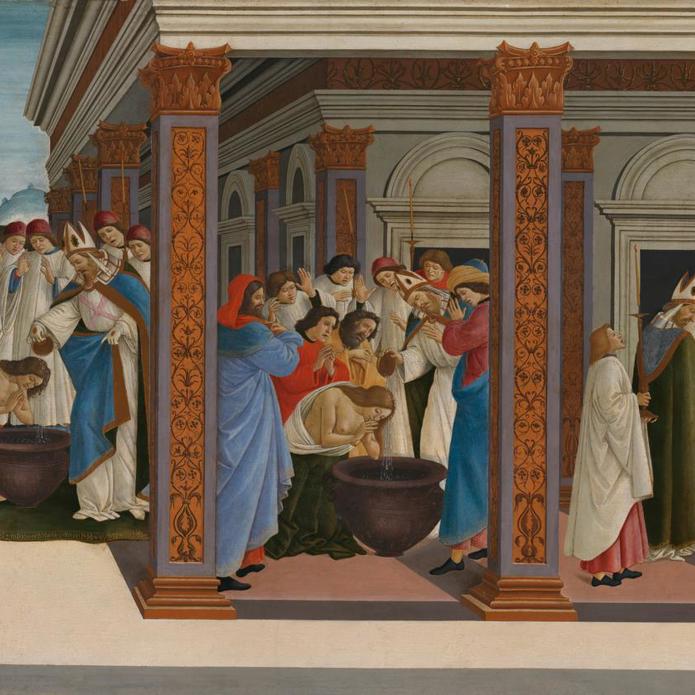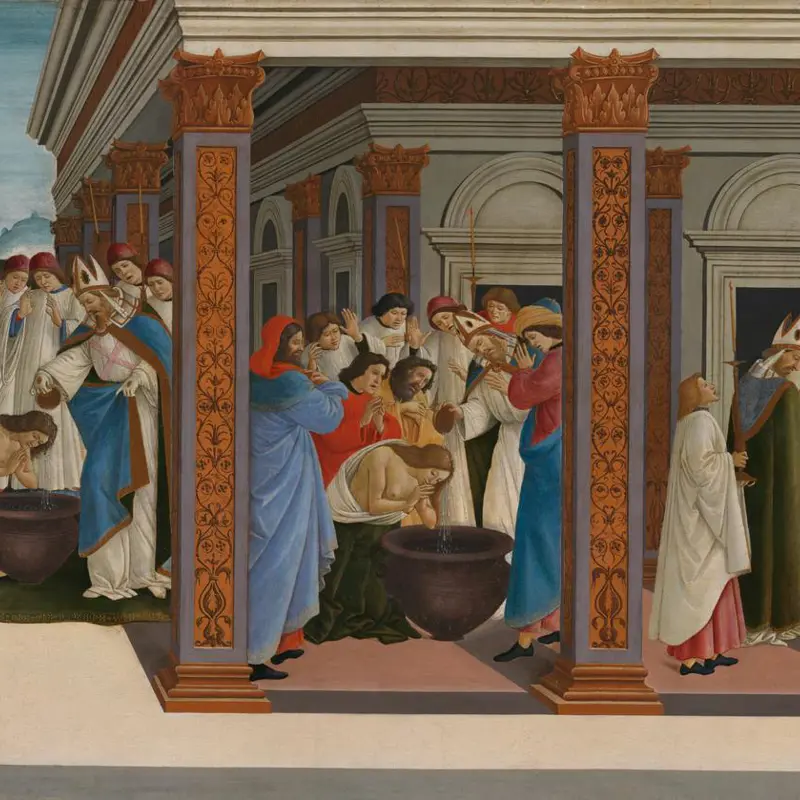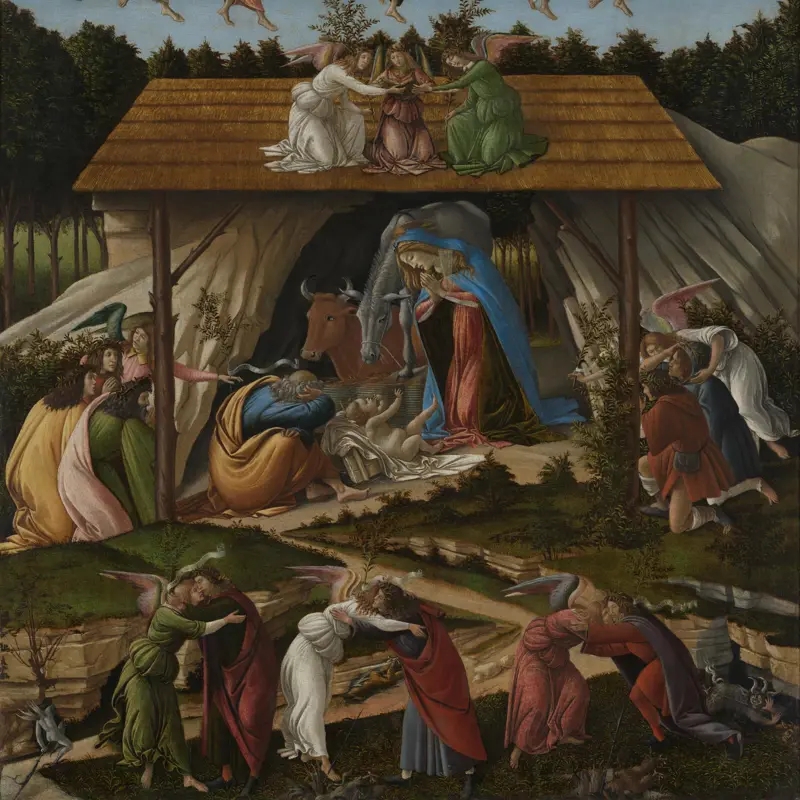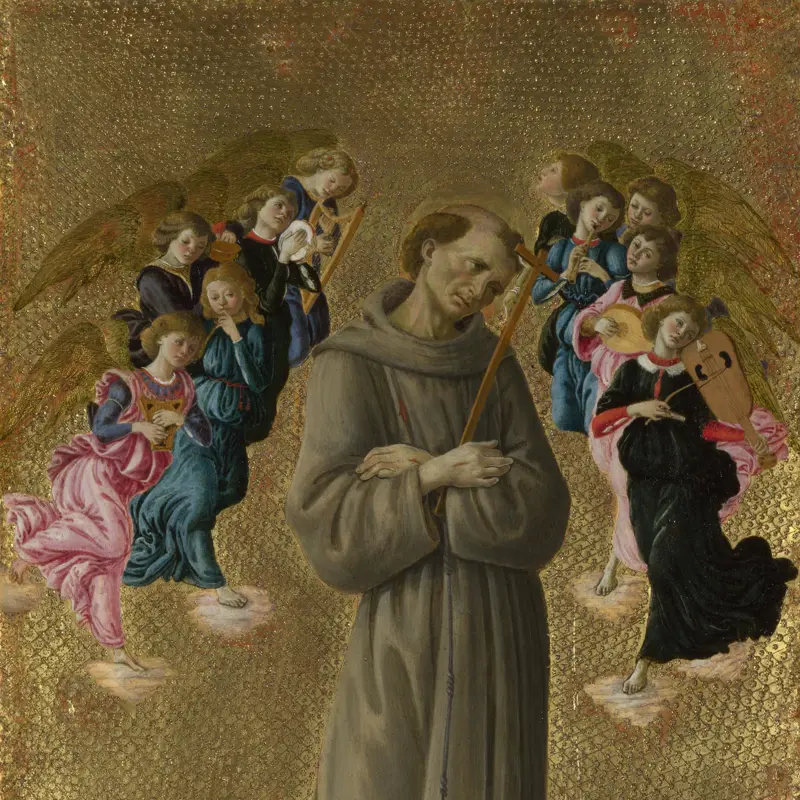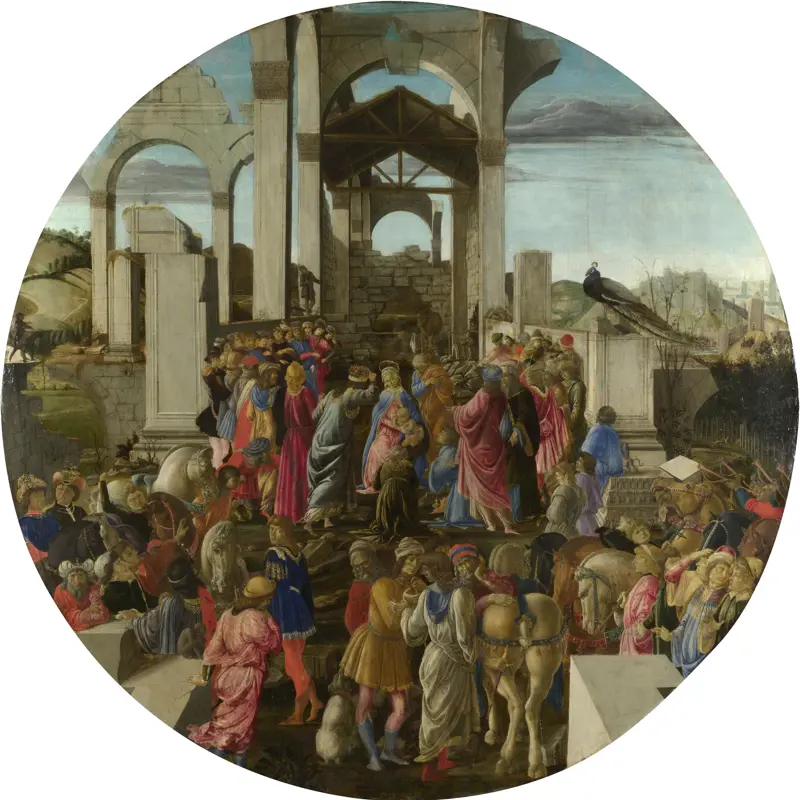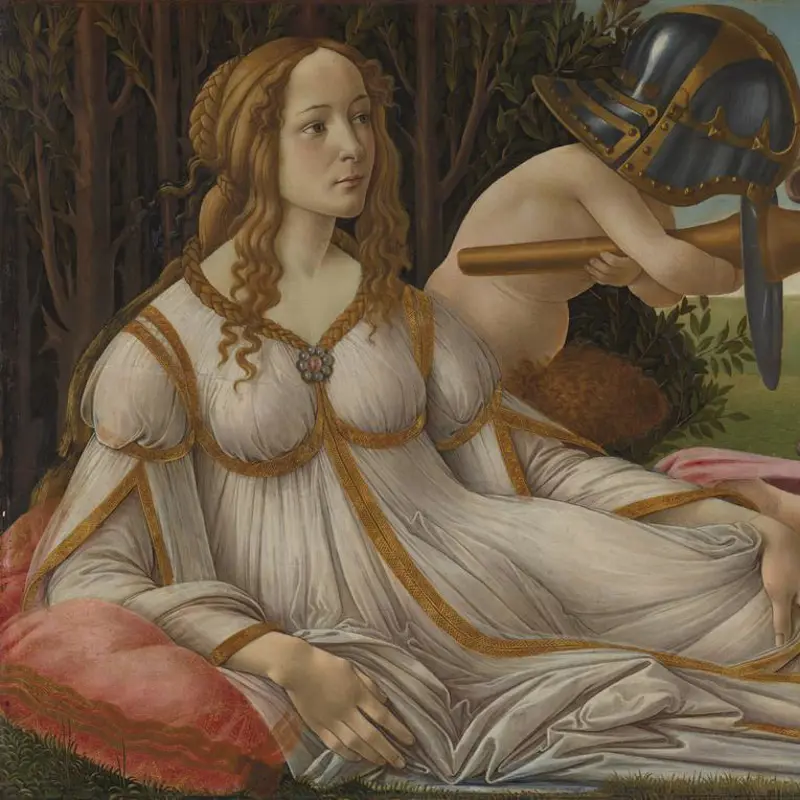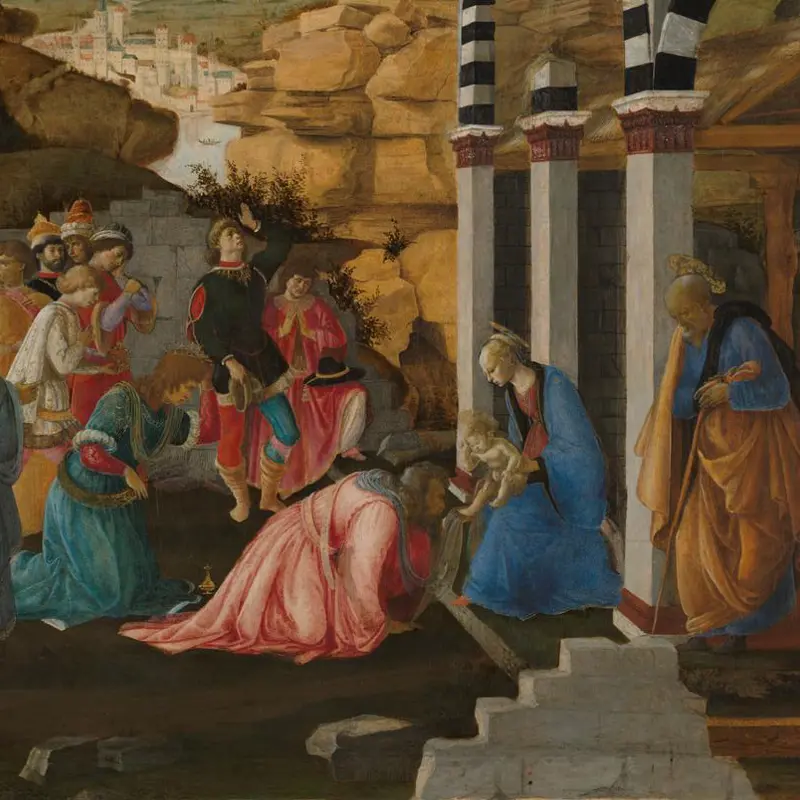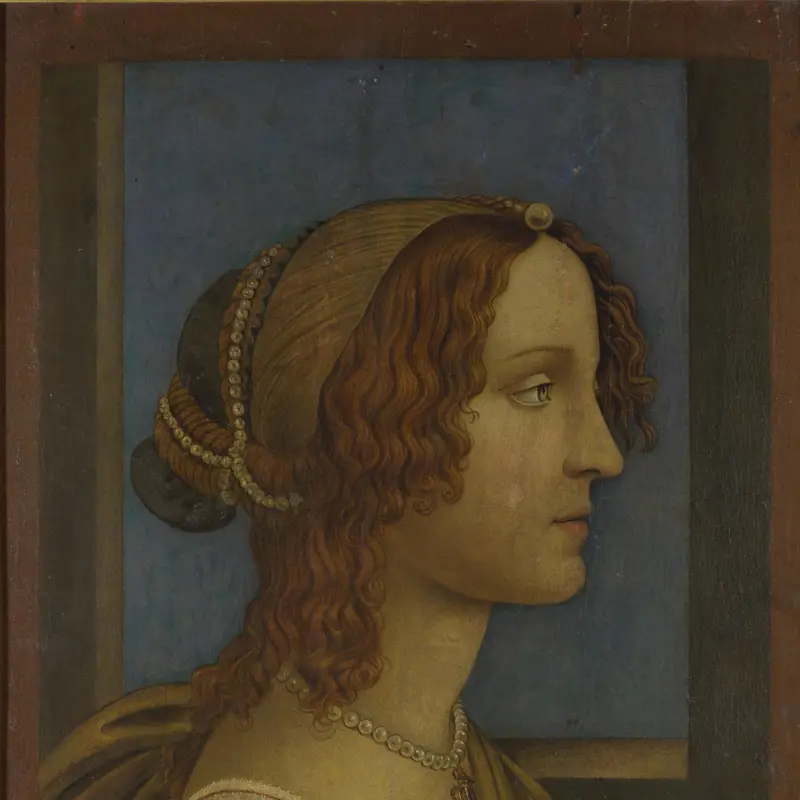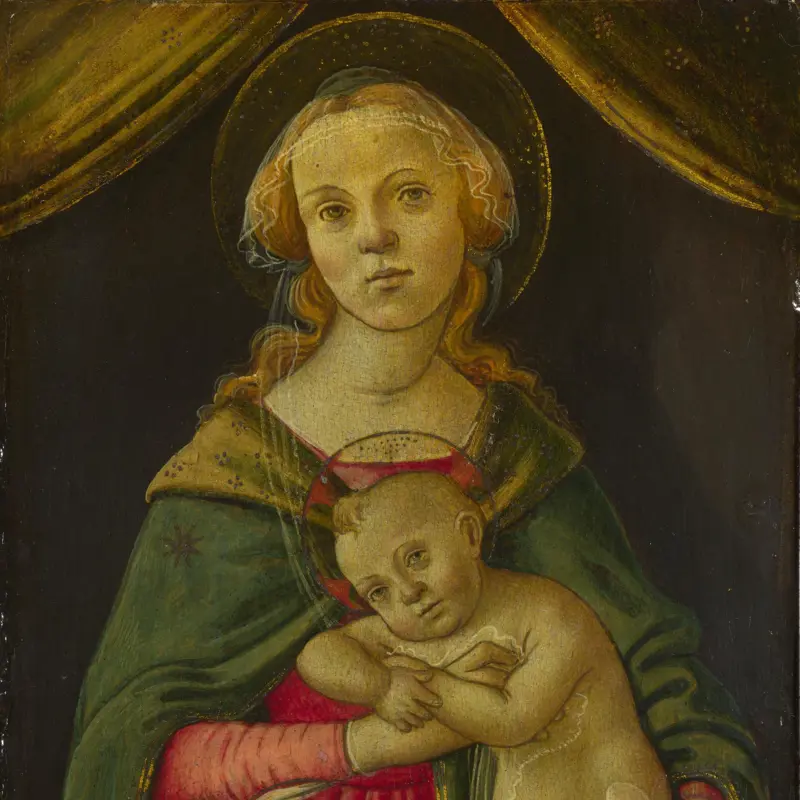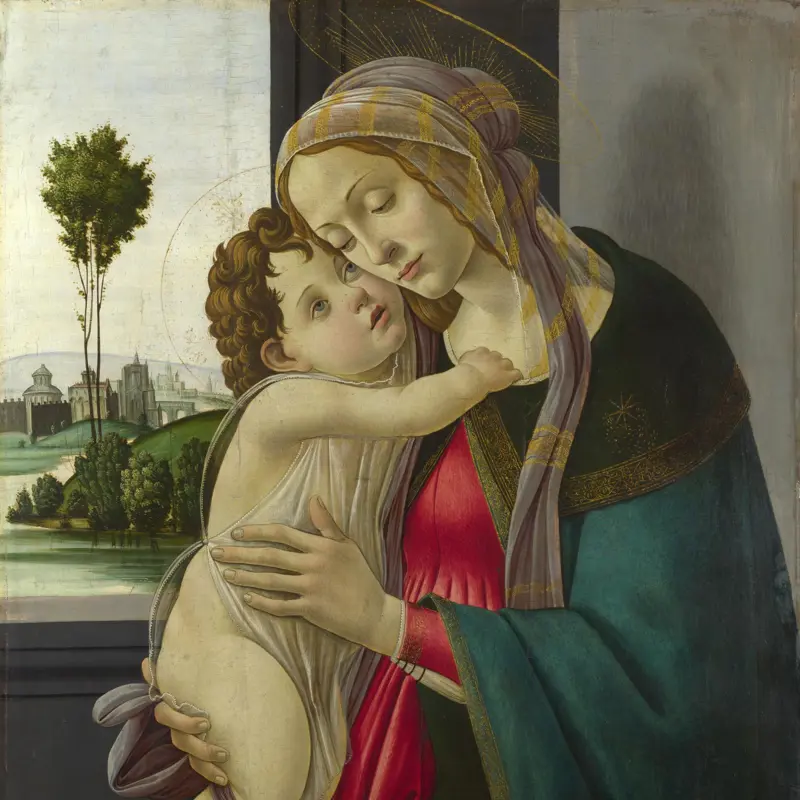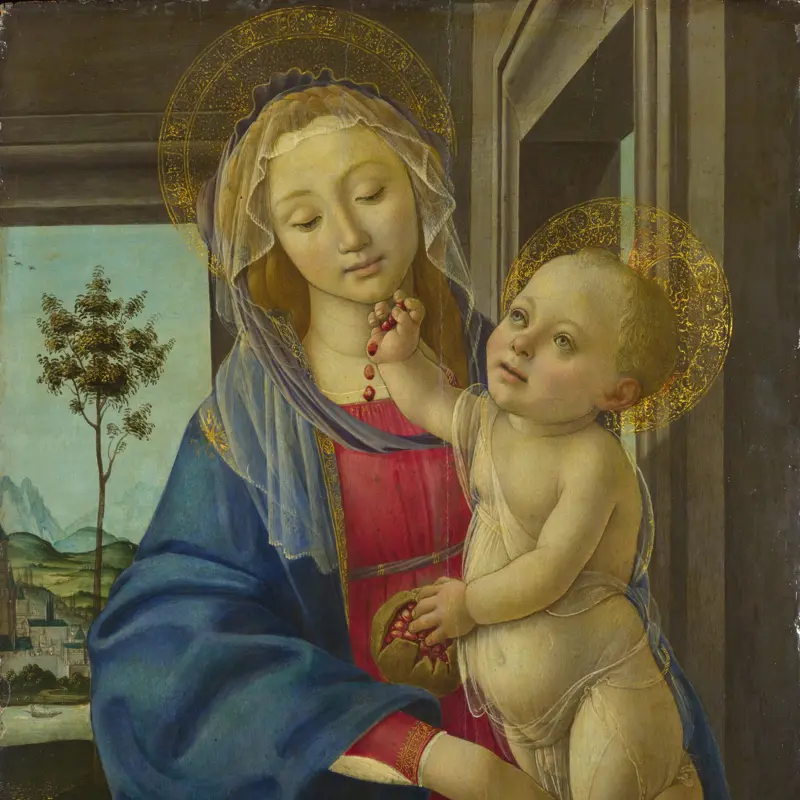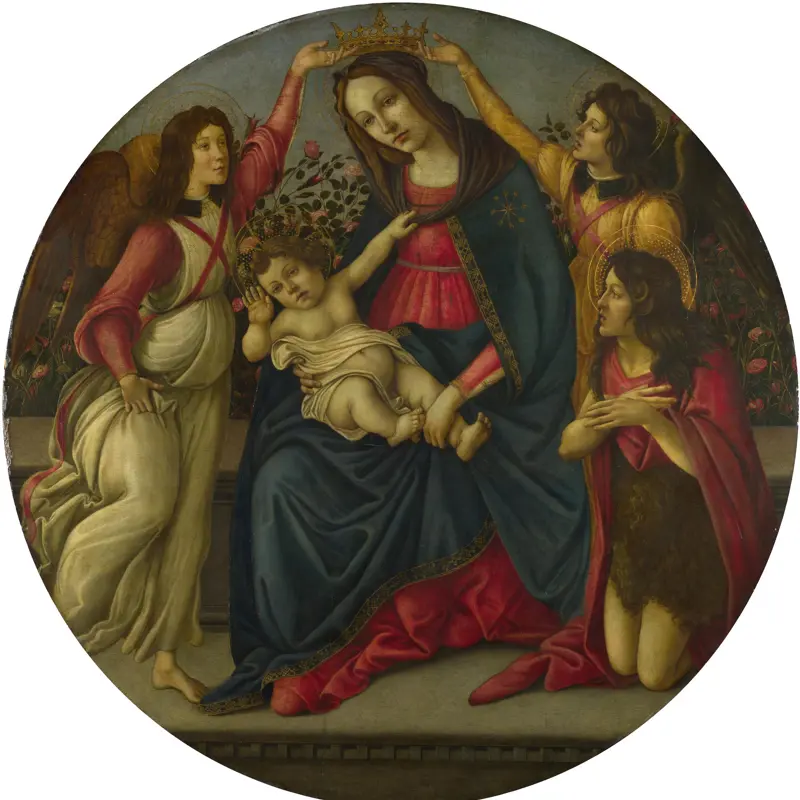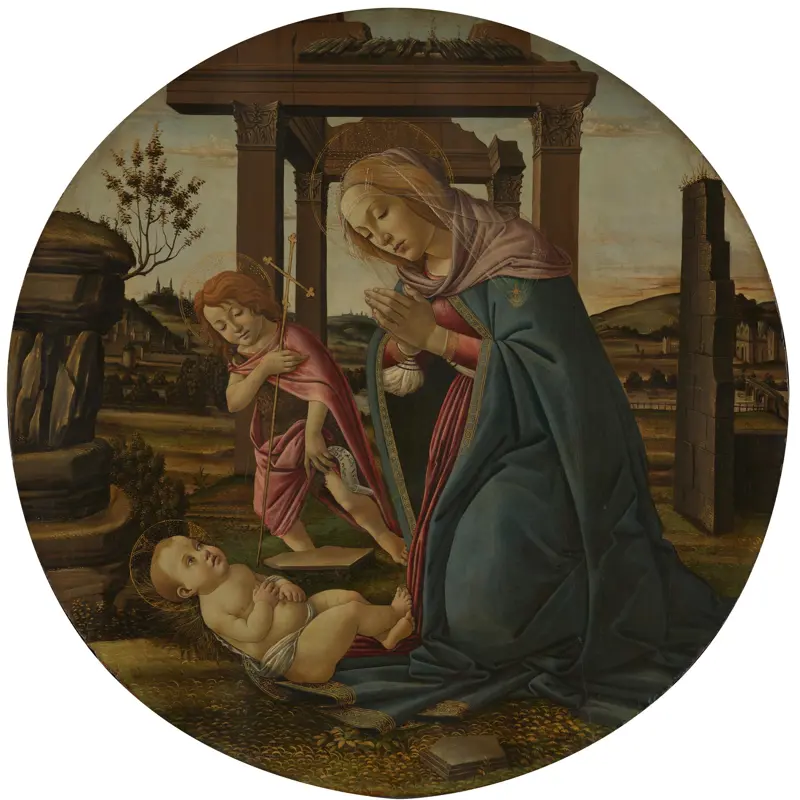Sandro Botticelli, 'Four Scenes from the Early Life of Saint Zenobius', about 1500
About the work
Overview
This painting was made as part of a group of four works that tell the story of the life of Florence’s patron saint, Zenobius; it is the first of the series. It shows four scenes of his early life as a Christian, from his rejection of marriage to his ordination as Bishop of Florence.
It can be read like a cartoon strip from left to right. In the first scene on the left Zenobius walks sadly away from his fiancée and crosses the road to be baptised under the loggia (open-sided gallery or room) of an elaborate building with columns decorated with gold. His mother is shown being baptised in the next scene. Finally, we find Zenobius kneeling before the pope who is about to make him bishop. He is accompanied by young men in white vestments – they might represent members of the religious group devoted to Zenobius, who may have ordered the pictures.
Key facts
Details
- Full title
- Four Scenes from the Early Life of Saint Zenobius
- Artist
- Sandro Botticelli
- Artist dates
- About 1445 - 1510
- Part of the series
- Two Spalliera Panels
- Date made
- About 1500
- Medium and support
- Egg tempera on wood
- Dimensions
- 66.7 × 149.2 cm
- Acquisition credit
- Mond Bequest, 1924
- Inventory number
- NG3918
- Location
- Room 60
- Collection
- Main Collection
Provenance
Additional information
Text extracted from the ‘Provenance’ section of the catalogue entry in Martin Davies, ‘National Gallery Catalogues: The Earlier Italian Schools’, London 1986; for further information, see the full catalogue entry.
Exhibition history
-
2009Botticelli.Städelsches Kunstinstitut und Städtische Galerie13 November 2009 - 28 February 2010
-
2010Frederick Cayley Robinson: Acts of MercyThe National Gallery (London)14 July 2010 - 17 October 2010
-
2019Botticelli: Heroines + HeroesIsabella Stewart Gardner Museum14 February 2019 - 19 May 2019
-
2020Masterpieces from the National Gallery, LondonThe National Museum of Western Art18 June 2020 - 18 October 2020The National Museum of Art3 November 2020 - 31 January 2021
-
2021Botticelli to Van Gogh: Masterpieces from the National Gallery, LondonNational Gallery of Australia5 March 2021 - 14 June 2021
Bibliography
-
1893H.C. Ulmann, Sandro Botticelli, Munich 1893
-
1894J.P. Richter, 'Italian Pictures at the New Gallery and at Burlington House', Art Journal, 1894, pp. 62-3
-
1894Royal Academy of Arts, Exhibition of Works by the Old Masters, and by Deceased Masters of the British School (exh. cat. Royal Academy of Arts, 1894), London 1894
-
1908H. Horne, Allessandro Filipepi, Commonly Called Sandro Botticelli, Painter of Florence, London 1908
-
1910J.P. Richter, The Mond Collection: An Appreciation, London 1910
-
1912C.J. Ffoulkes, 'Il catalogo mond', L'arte, XV, 1912, pp. 263-80
-
1916G. Poggi, 'Appunti d'archivio', Rivista d'arte, IX, 1916, pp. 62-7
-
1923P. Schubring, Cassoni: Truhen und Truhenbilder der italienischen Fruhrenaissance: Ein Beitrag zur Profanmalerei im Quattrocento, Leipzig 1923
-
1924R. Fry, 'The Mond Pictures in the National Gallery', The Burlington Magazine, XLIV/254, 1924, pp. 234-46
-
1924A. Venturi, 'La quadreria di Ludwig Mond', L'arte, XXVII, 1924, pp. 200-10
-
1951Davies, Martin, National Gallery Catalogues: The Earlier Italian Schools, London 1951
-
1958R. Salvini, Tutta la pittura del Botticelli, Milan 1958
-
1961M. Davies, The Earlier Italian Schools, 2nd edn, London 1961
-
1971F. Zeri, A Catalogue of the Collection of the Metropolitan Museum of Art: Florentine School, New York 1971
-
1978R. Lightbown, Sandro Botticelli, London 1978
-
1983K. Christiansen, 'Early Renaissance Narrative Painting in Italy', Metropolitan Museum of Art Bulletin, XLI/2, 1983, pp. 3-48
-
1984E. Callmann, 'Botticelli's Life of Saint Zenobius', Art Bulletin, LXVI/3, 1984, pp. 492-6
-
1986Davies, Martin, National Gallery Catalogues: The Earlier Italian Schools, revised edn, London 1986
-
1990C. Caneva, Botticelli: Catalogo completo dei dipinti, Florence 1990
-
1991J. Dunkerton et al., Giotto to Dürer: Early Renaissance Painting in the National Gallery, New Haven 1991
-
1994A.B. Barriault, Spalliera Paintings of Renaissance Tuscany: Fables of Poets for Patrician Homes, Univerisity Park PA 1994
-
1995P. Joannides, 'Late Botticelli: Archaism and Ideology', Arte Cristiana, LXXXIII/768, 1995, pp. 163-78
-
1995R. White and J. Pilc, 'Analyses of Paint Media', National Gallery Technical Bulletin, XVI, 1995, pp. 85-95
-
1996A.C. Blume, Studies in the Religious Paintings of Sandro Botticelli, Ann Arbor 1996
-
1996J. Dunkerton and A. Roy, 'The Materials of a Group of Late Fifteenth-Century Florentine Panel Paintings', National Gallery Technical Bulletin, XVII, 1996, pp. 20-31
-
2001
C. Baker and T. Henry, The National Gallery: Complete Illustrated Catalogue, London 2001
About this record
If you know more about this work or have spotted an error, please contact us. Please note that exhibition histories are listed from 2009 onwards. Bibliographies may not be complete; more comprehensive information is available in the National Gallery Library.
Images
About the series: Two Spalliera Panels
Overview
These two panels come from a series of four that were made by Botticelli late in his career, and which celebrate the life of Saint Zenobius, the patron saint of Florence who lived in the fifth century. The panels have the shape of paintings known as spalliere after the Italian word for shoulder: spalla. Paintings like this were usually hung at shoulder height, often in bedrooms. They were frequently made to celebrate marriages, but it seems unlikely this set was made for that purpose: it begins with Zenobius’s rejection of his fiancée in favour of a life in service of God. The panels show Zenobius’s conversion and baptism, his ordination as Bishop of Florence and the miracles that he performed there. Botticelli has painted young men in white robes as witnesses to many of these episodes; they may represent members of the religious youth group dedicated to the saint, the Compagnia della Purificazione e di San Zanobi (‘The company of the Purification and of Saint Zenobius’). It is possible that Botticelli painted these panels for their rooms.

